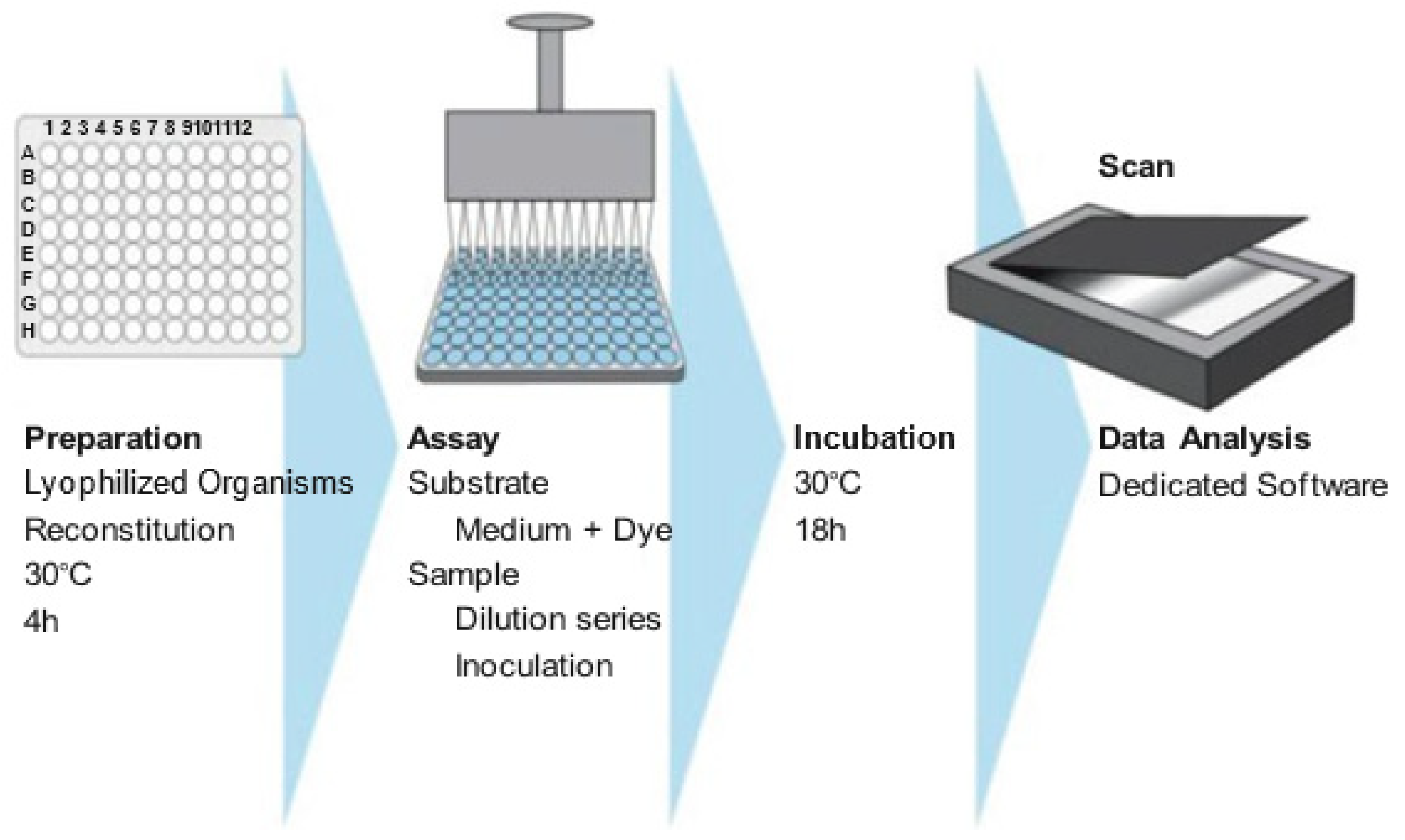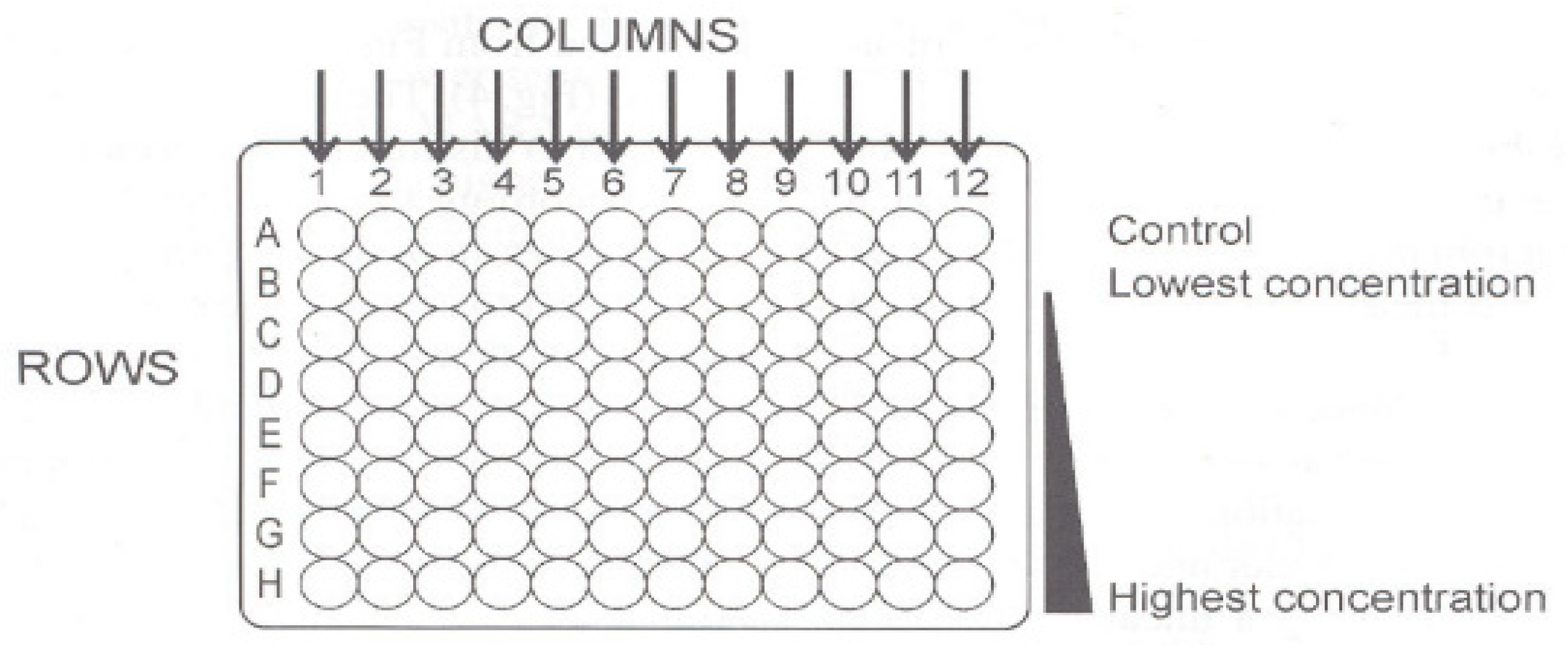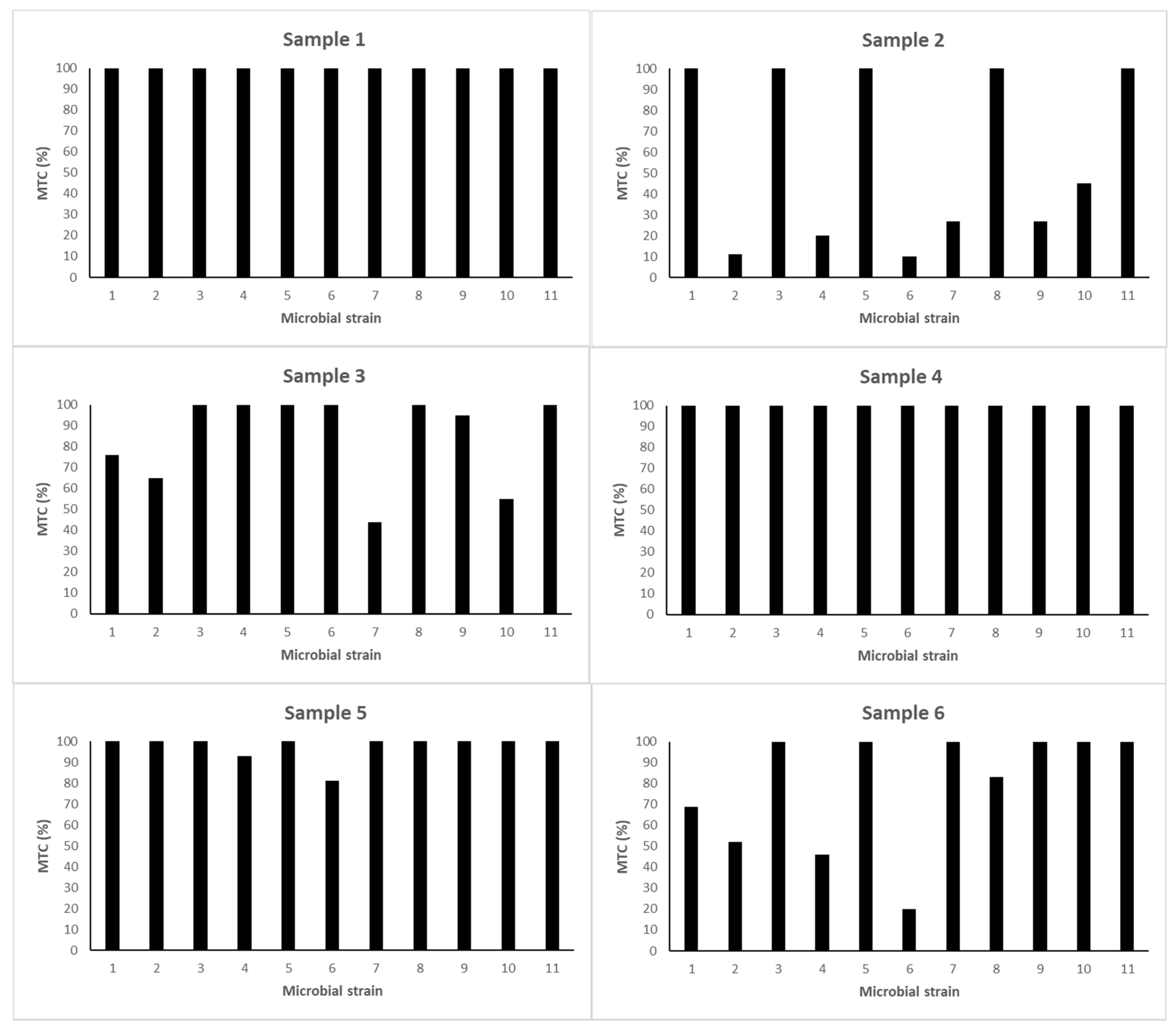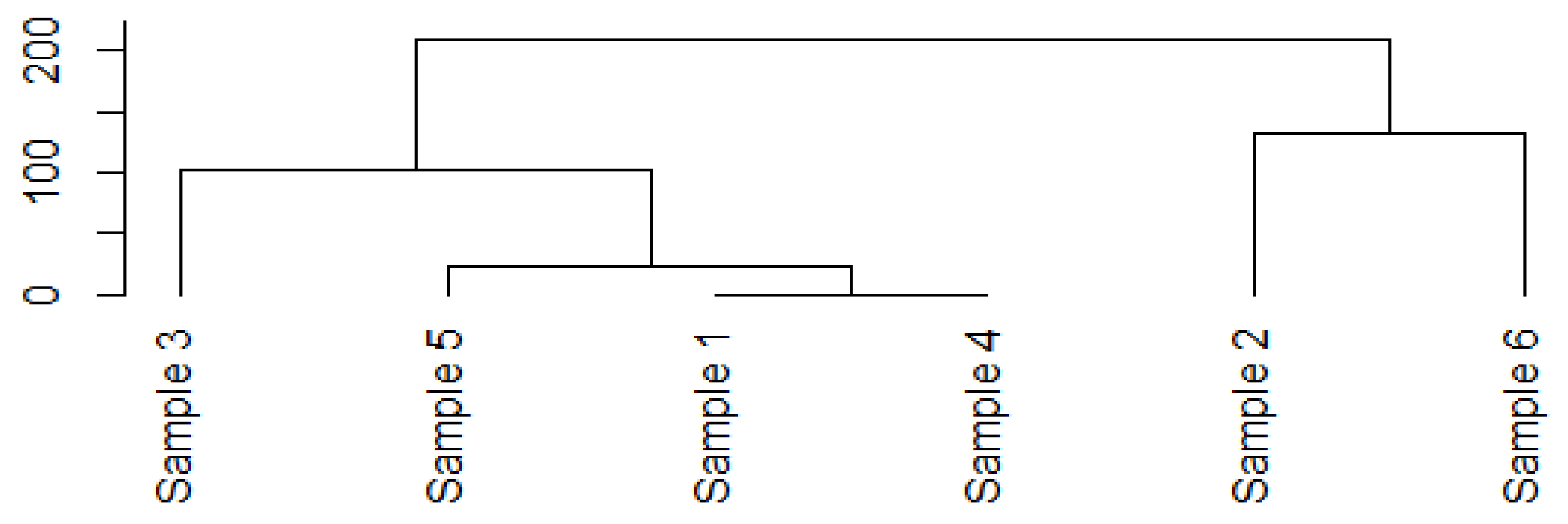Toxicity Testing by the Microbial Assay for Risk Assessment (MARA) in Relation to Trace Elements Content in King Bolete (Boletus edulis) Collected in Several Sites of Poland
Abstract
1. Introduction
2. Materials and Methods
2.1. Materials
2.2. Microbial Assay for Risk Assessment (MARA)
- Microbacterium species is a Gram-positive bacterium that has thermoduric, saprophytic, and nonmotile properties. It is widely found in both the dairy and the gastrointestinal tract [17];
- Brevundimonas diminuta is a Gram-negative bacterium used as a marker in the efficiency of a water filter [18];
- Citrobacter freundii is a facultative anaerobic Gram-negative bacterium that is widely found in the environment, food, and gastrointestinal tract. It is also known as a pathogen that causes health issues in the respiratory and urinary tract. However, it is beneficial in the bioremediation of copper [19];
- Comamonas testosteroni is an aerobic Gram-negative bacterium that is widely found in the soil. It is found in a very polluted environment [20];
- Enterococcus casseliflavus is a Gram-positive bacterium with a resistance to high temperatures up to 60 °C [21];
- Delftia acidovorans is a Gram-negative bacterium that is widely found in soil in water. It is known as gold nuggets due to its ability to dissolve gold into nanoparticles [22];
- Kurthia gibsonii is a Gram-positive bacterium that is commonly found in any environment contaminated with animal feces [23];
- Staphylococcus warneri is a Gram-positive bacterium that is generally found in human and animal skins. It is a commensal organism, which can rarely cause diseases, but in immunocompromised patients with invasive treatments or medical device implants may cause sepsis and endocarditis [24];
- Pseudomonas aurantiaca is a Gram-negative microorganism commonly found in soils [25];
- Serratia rubidaea is a Gram-negative bacterium that is likely found in water and soils [26];
- Pichia anomalia is a yeast widely found in industrial sewages, soils, grains, and sweet water [13].
2.2.1. Sample Preparation
2.2.2. Plate Preparation
2.2.3. Inoculation and Incubation
2.2.4. Test Measurement
2.2.5. MARA Toxicity Determination
2.3. Total Element Content Measurements
2.3.1. Microwave-Assisted Wet Digestion
2.3.2. Instrumentation
2.4. Statistical Analysis
3. Results and Discussion
3.1. Microbial Toxicity Concentration
3.2. Trace Elements Content
3.3. Mushroom Intake and Its Risk to Human
4. Conclusions
Author Contributions
Funding
Institutional Review Board Statement
Informed Consent Statement
Data Availability Statement
Conflicts of Interest
References
- Širić, I.; Falandysz, J. Contamination, bioconcentration and distribution of mercury in Tricholoma spp. mushrooms from southern and northern regions of Europe. Chemosphere 2020, 251, 126614. [Google Scholar] [CrossRef] [PubMed]
- Mleczek, M.; Niedzielski, P.; Kalač, P.; Budka, A.; Siwulski, M.; Gąsecka, M.; Rzymski, P.; Magdziak, Z.; Sobieralski, K. Multielemental analysis of 20 mushroom species growing near a heavily trafficked road in Poland. Environ. Sci. Pollut. Res. 2016, 23, 16280–16295. [Google Scholar] [CrossRef]
- Rudawska, M.; Leski, T. Macro- and microelement contents in fruiting bodies of wild mushrooms from the Notecka forest in west-central Poland. Food Chem. 2005, 92, 499–506. [Google Scholar] [CrossRef]
- Nieminen, P.; Mustonen, A.-M. Toxic Potential of Traditionally Consumed Mushroom Species—A Controversial Continuum with Many Unanswered Questions. Toxins 2020, 12, 639. [Google Scholar] [CrossRef]
- Cocchi, L.; Vescovi, L.; Petrini, L.E.; Petrini, O. Heavy metals in edible mushrooms in Italy. Food Chem. 2006, 98, 277–284. [Google Scholar] [CrossRef]
- Falandysz, J.J.; Kunito, T.; Kubota, R.; Bielawski, L.; Frankowska, A.; Tanabe, S. Multivariate characterization of elements accumulated in King BoleteBoletus edulismushroom at lowland and high mountain regions. J. Environ. Sci. Health Part A 2008, 43, 1692–1699. [Google Scholar] [CrossRef]
- García, M.A.; Alonso, J.; Melgar, M.J. Lead in edible mushroomsLevels and bioaccumulation factors. J. Hazard. Mater. 2009, 167, 777–783. [Google Scholar] [CrossRef]
- Commission, R. (EC) No. 629/2008 of 2 July 2008 amending Regulation (EC) No. 1881/2006 setting maximum levels for certain contaminants in foodstuffs. Off. J. Eur. Union 2008, 173, 6–9. [Google Scholar]
- Lyubenova, M.; Boteva, S. Biotests in Ecotoxicology: Current Practice and Problems. In Toxicology—New Aspects to This Scientific Conundrum; IntechOpen: London, UK, 2016. [Google Scholar]
- Wolska, L.; Sagajdakow, A.; Kuczyńska, A.; Namieśnik, J. Application of ecotoxicological studies in integrated environmental monitoring: Possibilities and problems. TrAC Trends Anal. Chem. 2007, 26, 332–344. [Google Scholar] [CrossRef]
- Markwiese, J.T.; Ryti, R.T.; Hooten, M.M.; Michael, D.I.; Hlohowskyj, I. Toxicity bioassays for ecological risk assessment in arid and semiarid ecosystems. Residue Rev. 2001, 168, 43–98. [Google Scholar]
- Gabrielson, J.; Kühn, I.; Colque-Navarro, P.; Hart, M.; Iversen, A.; McKenzie, D.; Möllby, R. Microplate-based microbial assay for risk assessment and (eco)toxic fingerprinting of chemicals. Anal. Chim. Acta 2003, 485, 121–130. [Google Scholar] [CrossRef]
- Sieroslawska, A. Evaluation of usefulness of Microbial Assay for Risk Assessment (MARA) in the cyanobacterial toxicity estimation. Environ. Monit. Assess. 2014, 186, 4629–4636. [Google Scholar] [CrossRef]
- Wadhia, K.; Dando, T.; Thompson, K.C. Intra-laboratory evaluation of Microbial Assay for Risk Assessment (MARA) for potential application in the implementation of the Water Framework Directive (WFD). J. Environ. Monit. 2007, 9, 953–958. [Google Scholar] [CrossRef]
- Bronowska, M.; Bystrzejewska-Piotrowska, G.; Sterębowski, R. Estimation of the acute cesium toxicity by the microbial assay for risk assessment (MARA) test. Nukleonika 2013, 58, 481–485. [Google Scholar]
- Nałȩcz-Jawecki, G.; Wadhia, K.; Adomas, B.; Piotrowicz-Cieślak, A.; Sawicki, J. Application of microbial assay for risk assessment biotest in evaluation of toxicity of human and veterinary antibiotics. Environ. Toxicol. 2010, 25, 487–494. [Google Scholar] [CrossRef]
- Percival, S.L.; Williams, D.W. Chapter Nine—Mycobacterium. In Microbiology of Waterborne Diseases, 2nd ed.; Percival, S.L., Yates, M.V., Williams, D.W., Chalmers, R.M., Gray, N.F., Eds.; Academic Press: London, UK, 2014; pp. 177–207. [Google Scholar]
- Ryan, M.P.; Pembroke, J.T. Brevundimonas spp: Emerging global opportunistic pathogens. Virulence 2018, 9, 480–493. [Google Scholar] [CrossRef]
- Lalaoui, R.; Djukovic, A.; Bakour, S.; Hadjadj, L.; Sanz, J.; Salavert, M.; López-Hontangas, J.L.; Sanz, M.A.; Ubeda, C.; Rolain, J.-M. Genomic characterization of Citrobacter freundii strains coproducing OXA-48 and VIM-1 carbapenemase enzymes isolated in leukemic patient in Spain. Antimicrob. Resist. Infect. Control. 2019, 8, 167. [Google Scholar] [CrossRef] [PubMed]
- Bayhan, G.I.; Tanir, G.; Karaman, I.; Ozkan, S. Comamonas testosteroni: An Unusual Bacteria Associated with Acute Appendicitis. Balk. Med. J. 2013, 30, 447–448. [Google Scholar] [CrossRef] [PubMed]
- Giraffa, G. Lactic Acid Bacteria: Enterococcus in Milk and Dairy Products. In Reference Module in Food Science; Elsevier: Amsterdam, The Netherlands, 2020. [Google Scholar]
- Mahmood, S.; Taylor, K.E.; Overman, T.L.; McCormick, M.I. Acute infective endocarditis caused by Delftia acidovorans, a rare pathogen complicating intravenous drug use. J. Clin. Microbiol. 2012, 50, 3799–3800. [Google Scholar] [CrossRef] [PubMed]
- Abdul-Mutalib, N.-A.; Nordin, S.A.; Osman, M.; Ishida, N.; Tashiro, K.; Sakai, K.; Tashiro, Y.; Maeda, T.; Shirai, Y. Pyrosequencing analysis of microbial community and food-borne bacteria on restaurant cutting boards collected in Seri Kembangan, Malaysia, and their correlation with grades of food premises. Int. J. Food Microbiol. 2015, 200, 57–65. [Google Scholar] [CrossRef]
- Kini, G.D.; Patel, K.; Parris, A.R.; Tang, J.S. An Unusual Presentation of Endocarditis Caused by Staphylococcus warneri. Open Microbiol. J. 2010, 4, 103–105. [Google Scholar] [CrossRef] [PubMed]
- Rovera, M.; Pastor, N.; Niederhauser, M.; Rosas, S.B. Evaluation ofPseudomonas chlororaphissubsp.aurantiacaSR1 for growth promotion of soybean and for control ofMacrophomina phaseolina. Biocontrol Sci. Technol. 2014, 24, 1012–1025. [Google Scholar] [CrossRef]
- Karkey, A.; Joshi, N.; Chalise, S.; Joshi, S.; Shrestha, S.; Nguyen, T.N.T.; Dongol, S.; Basnyat, B.; Baker, S.; Boinett, C.J. Outbreaks of Serratia marcescens and Serratia rubidaea bacteremia in a central Kathmandu hospital following the 2015 earthquakes. Trans. R. Soc. Trop. Med. Hyg. 2018, 112, 467–472. [Google Scholar] [CrossRef] [PubMed]
- Mleczek, M.; Siwulski, M.; Budka, A.; Mleczek, P.; Budzyńska, S.; Szostek, M.; Kuczyńska-Kippen, N.; Kalač, P.; Niedzielski, P.; Gąsecka, M.; et al. Toxicological risks and nutritional value of wild edible mushroom species -a half-century monitoring study. Chemosphere 2021, 263, 128095. [Google Scholar] [CrossRef] [PubMed]
- Schenk-Jaeger, K.M.; Rauber-Lüthy, C.; Bodmer, M.; Kupferschmidt, H.; Kullak-Ublick, G.A.; Ceschi, A. Mushroom poisoning: A study on circumstances of exposure and patterns of toxicity. Eur. J. Intern. Med. 2012, 23, e85–e91. [Google Scholar] [CrossRef]
- European Environment Agency. Air Quality in Europe—2020 Report; Publications Office of the European Union: Luxembourg, 2020.
- Filonchyk, M.; Hurynovich, V.; Yan, H. Impact of Covid-19 lockdown on air quality in the Poland, Eastern Europe. Environ. Res. 2020, 110454. [Google Scholar] [CrossRef]
- Brzezicha-Cirocka, J.; Mędyk, M.; Falandysz, J.; Szefer, P. Bio- and toxic elements in edible wild mushrooms from two regions of potentially different environmental conditions in eastern Poland. Environ. Sci. Pollut. Res. 2016, 23, 21517–21522. [Google Scholar] [CrossRef]
- Falandysz, J.; Jędrusiak, A.; Lipka, K.; Kannan, K.; Kawano, M.; Gucia, M.; Brzostowski, A.; Dadej, M. Mercury in wild mushrooms and underlying soil substrate from Koszalin, North-central Poland. Chemosphere 2004, 54, 461–466. [Google Scholar] [CrossRef]
- Ferrante, M.; Maria, F.; Copat, C.; Morina, S.; Caterina, L.; Mauceri, C.; Gea Oliveri, C. Air Pollution in High-Risk Sites-Risk Analysis and Health Impact; IntechOpen: London, UK, 2015. [Google Scholar]
- Zhang, D.; Frankowska, A.; Jarzyska, G.; Kojta, A.; Drewnowska, M.; Wydmaska, D.; Bielawski, L.; Wang, J.; Falandysz, J. Metals of King Bolete (Boletus edulis) Bull.: Fr. collected at the same site over two years. Afr. J. Agric. Res. 2010, 5, 3050–3055. [Google Scholar] [CrossRef]
- Falandysz, J.; Frankowska, A.; Jarzyńska, G.; Dryżałowska, A.; Kojta, A.K.; Zhang, D. Survey on composition and bioconcentration potential of 12 metallic elements in King Bolete (Boletus edulis) mushroom that emerged at 11 spatially distant sites. J. Environ. Sci. Health Part B 2011, 46, 231–246. [Google Scholar] [CrossRef]
- Gaso, M.; Segovia, N.; Morton, O.; Cervantes, M.; Godinez, L.; Peña, P.; Acosta, E. 137Cs and relationships with major and trace elements in edible mushrooms from Mexico. Sci. Total. Environ. 2000, 262, 73–89. [Google Scholar] [CrossRef]
- Stahl, T.; Falk, S.; Rohrbeck, A.; Georgii, S.; Herzog, C.; Wiegand, A.; Hotz, S.; Boschek, B.; Zorn, H.; Brunn, H. Migration of aluminum from food contact materials to food—A health risk for consumers? Part I of III: Exposure to aluminum, release of aluminum, tolerable weekly intake (TWI), toxicological effects of aluminum, study design, and methods. Environ. Sci. Eur. 2017, 29, 1–8. [Google Scholar] [CrossRef] [PubMed]
- Institute of Medicine Food and Nutrition Board. Dietary Reference Intakes for Vitamin A, Vitamin K, Arsenic, Boron, Chromium, Copper, Iodine, Iron, Manganese, Molybdenum, Nickel, Silicon, Vanadium, and Zinc. J. Am. Diet. Assoc. 2001, 101, 294–301. [Google Scholar]
- World Health Organization. Trace Elements in Human Nutrition and Health (A Report of a Re−Evaluation of the Role of Trace Elements in Human Health and Nutrition); World Health Organization: Geneva, Switzerland, 1996. [Google Scholar]
- Royse, D.J.; Baars, J.; Tan, Q. Current Overview of Mushroom Production in the World. In Edible and Medicinal Mushrooms: Technology and Applications; Zied, D.C., Pardo-Giménez, A., Eds.; Wiley-Blackwell: Hoboken, NJ, USA, 2017; pp. 5–13. [Google Scholar] [CrossRef]






| Strain No. | Microbial Name | Characteristics |
|---|---|---|
| S1 | Microbacterium species | Gram (+) |
| S2 | Brevundimonas diminuta | Gram (−) |
| S3 | Citrobacter freundii | Gram (−) |
| S4 | Comamonas testosteroni | Gram (−) |
| S5 | Enterococcus casseliflavus | Gram (+) |
| S6 | Delftia acidovorans | Gram (−) |
| S7 | Kurthia gibsonii | Gram (+) |
| S8 | Staphylococcus warneri | Gram (+) |
| S9 | Pseudomonas aurantiaca | Gram (−) |
| S10 | Serratia rubidaea | Gram (−) |
| S11 | Pichia anomalia | Yeast |
| Sample | Average MTC (%) | Minimum MTC (%) | Most Sensitive Organism | Overall Effect |
|---|---|---|---|---|
| 1 | >max | 100 | - | No or very low toxicity |
| 2 | 43 | 10 | No. 6 Delftia acidovorans | No or very low toxicity |
| 3 | 85 | 44 | No. 7 Kurthia gibsonii | No or very low toxicity |
| 4 | >max | 100 | - | No or very low toxicity |
| 5 | >max | 81 | No. 6 Delftia acidovorans | No or very low toxicity |
| 6 | 75 | 20 | No. 6 Delftia acidovorans | No or very low toxicity |
| Elements | Fraction | Samples (mg kg−1 DW) | |||||
|---|---|---|---|---|---|---|---|
| 1 | 2 | 3 | 4 | 5 | 6 | ||
| Al | Total | 2.34 | 4.24 | 44.9 | 107 | 542 | 58.3 |
| Water | 1.00 | 0.85 | 3.23 | 5.28 | 7.18 | 2.14 | |
| % | 43 | 20 | 7.2 | 4.9 | 1.3 | 3.7 | |
| Cr | Total | <0.01 | <0.01 | <0.01 | 0.01 | 0.05 | <0.01 |
| Water | <0.01 | <0.01 | <0.01 | <0.01 | <0.01 | <0.01 | |
| % | - | - | - | - | - | - | |
| Cu | Total | 26.0 | 36.3 | 15.7 | 9.37 | 9.92 | 11.7 |
| Water | 5.41 | 8.34 | 15.3 | 4.63 | 4.02 | 3.47 | |
| % | 21 | 23 | 97 | 49 | 41 | 30 | |
| Fe | Total | 10.9 | 16.0 | 55.7 | 106 | 741 | 98.6 |
| Water | <0.01 | <0.01 | 7.18 | <0.01 | 0.92 | <0.01 | |
| % | - | - | 13 | - | 0.1 | - | |
| Ni | Total | 0.39 | 0.98 | 1.74 | 0.61 | 1.12 | 0.43 |
| Water | <0.01 | 0.20 | 1.23 | 0.23 | 0.23 | 0.24 | |
| % | - | 21 | 70 | 38 | 20 | 56 | |
| Zn | Total | 76.8 | 83.2 | 91.4 | 46.5 | 23.6 | 78.7 |
| Water | 16.0 | 5.65 | 73.7 | 8.54 | 12.9 | 21.4 | |
| % | 21 | 6.8 | 81 | 18 | 55 | 27 | |
| Elements | UL (mg day−1) | Sample (kg) | |||||
|---|---|---|---|---|---|---|---|
| 1 | 2 | 3 | 4 | 5 | 6 | ||
| Al | 9.29 [37] | 3.97 | 2.19 | 0.21 | 0.09 | 0.02 | 0.16 |
| Cr | 0.25 [39] | N/A | N/A | N/A | 25.0 | 5.00 | N/A |
| Cu | 10.0 [38] | 0.38 | 0.28 | 0.64 | 1.07 | 1.01 | 0.85 |
| Fe | 45.0 [38] | 4.13 | 2.81 | 0.81 | 0.42 | 0.06 | 0.46 |
| Ni | 1.00 [38] | N/A | 1.02 | 0.57 | 1.64 | 0.89 | 2.33 |
| Zn | 40.0 [38] | 0.52 | 0.48 | 0.44 | 0.86 | 1.69 | 0.51 |
| Total maximum daily intake (kg) | 0.38 | 0.28 | 0.21 | 0.09 | 0.02 | 0.16 | |
Publisher’s Note: MDPI stays neutral with regard to jurisdictional claims in published maps and institutional affiliations. |
© 2021 by the authors. Licensee MDPI, Basel, Switzerland. This article is an open access article distributed under the terms and conditions of the Creative Commons Attribution (CC BY) license (https://creativecommons.org/licenses/by/4.0/).
Share and Cite
Zubaidi, M.A.; Proch, J.; Konieczny, P.; Tomczyk, Ł. Toxicity Testing by the Microbial Assay for Risk Assessment (MARA) in Relation to Trace Elements Content in King Bolete (Boletus edulis) Collected in Several Sites of Poland. Appl. Sci. 2021, 11, 4166. https://doi.org/10.3390/app11094166
Zubaidi MA, Proch J, Konieczny P, Tomczyk Ł. Toxicity Testing by the Microbial Assay for Risk Assessment (MARA) in Relation to Trace Elements Content in King Bolete (Boletus edulis) Collected in Several Sites of Poland. Applied Sciences. 2021; 11(9):4166. https://doi.org/10.3390/app11094166
Chicago/Turabian StyleZubaidi, Muhamad Alfiyan, Jędrzej Proch, Piotr Konieczny, and Łukasz Tomczyk. 2021. "Toxicity Testing by the Microbial Assay for Risk Assessment (MARA) in Relation to Trace Elements Content in King Bolete (Boletus edulis) Collected in Several Sites of Poland" Applied Sciences 11, no. 9: 4166. https://doi.org/10.3390/app11094166
APA StyleZubaidi, M. A., Proch, J., Konieczny, P., & Tomczyk, Ł. (2021). Toxicity Testing by the Microbial Assay for Risk Assessment (MARA) in Relation to Trace Elements Content in King Bolete (Boletus edulis) Collected in Several Sites of Poland. Applied Sciences, 11(9), 4166. https://doi.org/10.3390/app11094166








